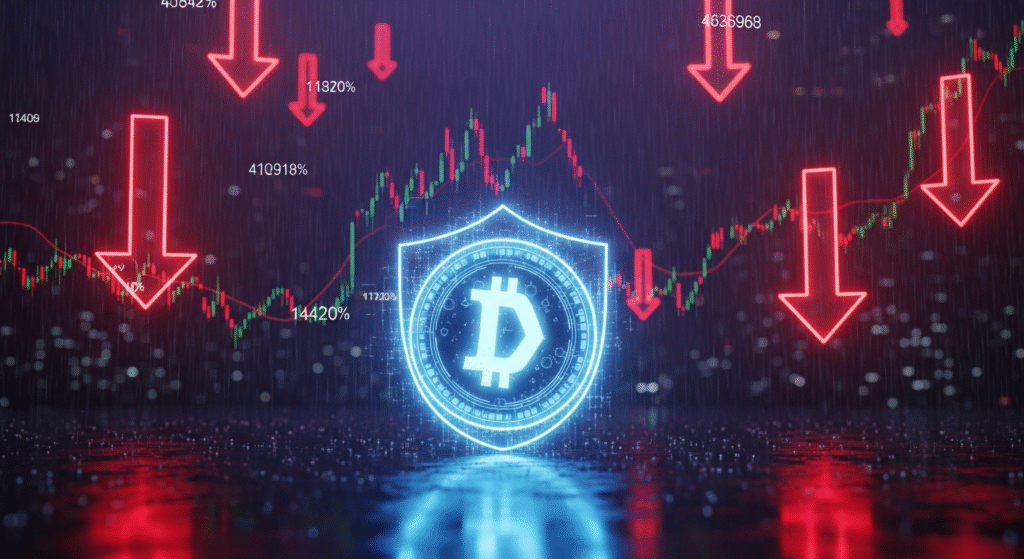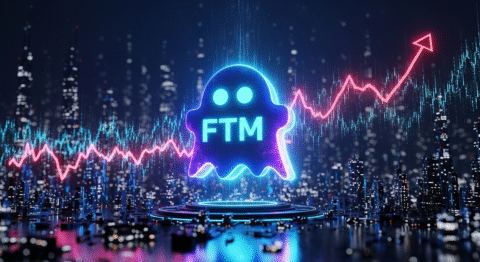Worried About Your Altcoins in This Bear Market? Unlock 7 Vital Secrets for Altcoins & Memes
Is it possible to not just survive, but thrive when the crypto market turns south? Many investors have watched their portfolios shrink during past downturns, feeling the sting of unrealized losses. But what if there were actionable strategies, backed by data, to navigate the stormy seas of a Bear Market? As we navigate the current crypto landscape, understanding the resilience of altcoins and meme coins, and how to approach them during periods of contraction, is more critical than ever. This guide dives deep into the secrets that can help you protect and even grow your investments, even when the market sentiment is decidedly bearish.
The overarching sentiment across financial markets, and particularly within the often-turbulent world of digital assets, is an ongoing concern about economic stability and its ripple effects. When the broader market experiences a downturn, the cryptocurrency space, known for its inherent volatility, often feels the impact amplified. This is especially true for altcoins and meme coins, which are frequently seen as higher-risk, higher-reward assets. Understanding what drives these markets, their unique characteristics, and the strategic approaches necessary to weather a Bear Market is paramount for any investor looking to maintain their financial health and capitalize on opportunities.
Crypto Market Overview: Navigating the Tides
The cryptocurrency market is a dynamic ecosystem, constantly evolving with new trends, technological advancements, and shifts in investor sentiment. Currently, we’re observing a complex interplay of factors influencing the landscape. While Bitcoin and Ethereum often set the tone, the performance of altcoins and meme coins remains a keenly watched indicator of broader market appetite for risk.
In recent times, we’ve seen periods of significant altcoin underperformance relative to Bitcoin, a common characteristic of a Bear Market. This is often driven by a flight to perceived safety, with investors reallocating capital to more established digital assets or even traditional markets. Meme coins, fueled by social media trends and community sentiment, can experience extreme volatility. During a Bear Market, their unpredictable nature can lead to dramatic price drops. However, it’s also in these volatile periods that discerning investors might find undervalued gems.
The prevalence of airdrops continues to be a strategy employed by new projects to gain traction and distribute tokens. While many airdrops are low-value or even scams, some can offer early investors exposure to potentially promising new technologies. Understanding the current airdrop landscape—which projects are active, and what their underlying value propositions are—can be a nuanced way to engage with the market during testing times. The key takeaway is that the crypto market, even in a Bear Market, is not monolithic. There are always specific niches and assets exhibiting unique behaviors.

The Core Concept: Navigating the Altcoin & Meme Coin Universe
To effectively strategize in a Bear Market, it’s crucial to understand the nature of altcoins and meme coins, and the mechanics of airdrops. These digital assets, while often grouped together, possess distinct characteristics and appeal.
What Are Altcoins, Meme Coins, and Airdrops?
Altcoins (alternative coins) are any cryptocurrencies other than Bitcoin. They emerged with the goal of improving upon Bitcoin’s perceived limitations or exploring different use cases. This vast category includes everything from major players like Ethereum, Solana, and Cardano, designed for smart contracts and decentralized applications (dApps), to niche tokens focused on specific industries like gaming, supply chain management, or privacy. Altcoins aim to offer innovation, faster transaction speeds, lower fees, or entirely new functionalities compared to Bitcoin.
Meme Coins, often referred to as “joke coins,” are cryptocurrencies that derive their value primarily from internet memes, viral social media campaigns, and community enthusiasm rather than underlying technological innovation or utility. Dogecoin, born as a satirical take on Bitcoin, and Shiba Inu, heavily influenced by Dogecoin, are prime examples. While many meme coins lack intrinsic value, their popularity can lead to astonishing price pumps when endorsed by influencers or amplified by online communities. Their performance is often highly speculative and heavily reliant on social sentiment, making them particularly susceptible to sharp declines in a Bear Market.
Airdrops are a marketing tactic used by cryptocurrency projects to distribute free tokens to a wide audience. Typically, users receive these tokens by holding a certain amount of another cryptocurrency, completing simple tasks (like following social media accounts), or signing up for a project’s newsletter. Airdrops are often used to build community, increase token distribution, and generate awareness for a new project, especially during the early stages of development. In a Bear Market, airdrops can provide individuals with an opportunity to acquire new tokens without upfront investment, though the value and long-term success of these tokens can vary dramatically.
Key Components & Technologies
The technological underpinnings of altcoins and meme coins can vary significantly:
- Blockchain Technology: The foundational technology for most cryptocurrencies. Different blockchains offer varying consensus mechanisms (Proof-of-Work, Proof-of-Stake), transaction speeds, scalability solutions, and smart contract capabilities. For example, Ethereum’s transition to Proof-of-Stake aims to make it more energy-efficient and scalable, attracting developers for DeFi and NFTs. Solana boasts high transaction throughput, positioning itself for applications requiring rapid processing.
- Smart Contracts: Programmable contracts that automatically execute when predefined conditions are met. This is the backbone of DeFi, NFTs, and many dApps built on platforms like Ethereum, Binance Smart Chain, and Solana. The functionality of a smart contract platform dictates the potential use cases for its associated altcoins.
- Decentralized Finance (DeFi): A burgeoning sector of crypto aiming to recreate traditional financial services without intermediaries. Altcoins play a crucial role in DeFi, powering lending protocols, decentralized exchanges (DEXs), and yield farming opportunities. Understanding DeFi mechanics is key to evaluating many altcoins, especially their ability to generate yield even in a Bear Market.
- Tokenomics: The economic model of a cryptocurrency, encompassing supply, distribution, and utility. Well-designed tokenomics can foster scarcity and demand, crucial for long-term value. Conversely, poor tokenomics, such as an infinite supply without commensurate demand, can lead to inflation and devaluation, especially in a Bear Market.
- Community & Governance: For many altcoins and particularly meme coins, the strength and engagement of their community are paramount. Governance models, where token holders can vote on protocol changes, also play a role in the long-term viability and adoption of a project, offering a form of decentralization that can make some assets more resilient.
The Data-Driven Perspective: Quantifying Opportunities and Risks
Making informed decisions in any market, especially a Bear Market, requires a reliance on data. Understanding market trends, performance metrics, and the underlying economics of digital assets is non-negotiable.
Market Data & Trends
Historically, altcoins tend to follow Bitcoin’s price movements, often with greater magnitude. During bull runs, altcoins can see exponential gains, but in a Bear Market, they often experience steeper percentage drops than Bitcoin. Data from past bear cycles shows that when Bitcoin dominance increases, it often signifies a shift away from altcoins. For instance, following the 2017 bull run, the Altcoin bear market of 2018 saw many altcoins lose over 90% of their value.
Meme coins are even more susceptible to these trends. Their prices are often driven by social media hype cycles, which can be intensified during bullish periods and can be brutally extinguished during downturns. Data aggregators often show massive trading volumes for meme coins during rallies, followed by stark declines and reduced liquidity in a Bear Market.
Airdrops, while not directly traded initially, also demonstrate trends. The success rate of airdropped tokens can be tracked by observing their subsequent trading performance. Projects that conduct airdrops often see an initial spike in interest, but their long-term viability depends on the utility and adoption of the underlying technology. Data on post-airdrop token performance can reveal whether the project managed to retain its community and developers, a crucial factor for resilience in a Bear Market.
Tokenomics & Market Health
Analyzing tokenomics is critical for any crypto investment, but especially when navigating a Bear Market.
- Supply and Demand: A finite supply, or a burn mechanism that reduces circulating supply, can create scarcity, potentially offsetting bearish price pressure. Conversely, an inflationary token supply with no matching demand will likely see its value erode significantly in a Bear Market.
- Utility and Use Case: Altcoins with strong, demonstrable utility and real-world use cases tend to be more resilient. Projects solving real problems, enabling new technologies, or offering essential services are more likely to retain value than those with speculative or purely hype-driven models. For example, utility tokens powering decentralized applications have a tangible demand.
- Staking and Yield Generation: In a Bear Market, opportunities to earn yield through staking or providing liquidity can be attractive. However, it’s crucial to analyze the sustainability of these yields. Unsustainably high yields often come with proportionally high risks. Community-driven platforms that offer stable, modest yields might be a safer bet.
- Market Capitalization and Liquidity Deepness: Larger market cap altcoins generally have deeper liquidity, meaning trades have less of an impact on the price. This offers some protection against extreme volatility during a Bear Market. Smaller, illiquid tokens can see their prices manipulated or fall off a cliff with even minor selling pressure.
Risks, Challenges & Competition
Investing in altcoins and meme coins, especially in a Bear Market, comes with inherent risks and challenges. Understanding these is key to managing your portfolio effectively.
Risks of Altcoins and Meme Coins
- Extreme Volatility: Altcoins and meme coins are significantly more volatile than Bitcoin and traditional assets. Prices can swing by tens or even hundreds of percent in a single day. This is amplified in a Bear Market, where negative sentiment can trigger rapid and severe price drops.
- Security Vulnerabilities: Many altcoins, particularly newer ones, are built on experimental technology. Smart contract bugs, hacking risks, and protocol exploits are not uncommon, leading to total loss of invested funds.
- Regulatory Uncertainty: The regulatory landscape for cryptocurrencies is still evolving globally. Altcoins and meme coins, often perceived as riskier, could face stricter regulations or outright bans in certain jurisdictions, impacting their value and tradability.
- Lack of Utility and Adoption: Many altcoins fail to gain traction or achieve widespread adoption. If a project lacks a clear use case or a growing user base, its token value is unlikely to be sustained, especially in a Bear Market. Meme coins, by definition, often lack inherent utility, making them entirely dependent on market sentiment.
- Rug Pulls and Scams: The decentralized nature of crypto makes it a fertile ground for scams. “Rug pulls,” where developers abandon a project and abscond with investor funds, are particularly prevalent in the rapidly growing altcoin and meme coin spaces.
How Do Altcoins & Meme Coins Stack Up Against Competitors?
Here’s a simplified comparison, acknowledging that the “competitors” can be other cryptocurrencies or even traditional investments:
| Feature | Bitcoin (BTC) | Major Altcoins (e.g., ETH, SOL) | Meme Coins (e.g., DOGE, SHIB) |
|---|---|---|---|
| Primary Goal | Store of Value, Digital Gold | Smart Contracts, dApps, DeFi, NFTs | Community, Entertainment, Speculation |
| Utility | Primarily as a medium of exchange/store of value | Broad and diverse (DeFi, NFTs, Gaming, etc.) | Minimal to none, driven by community |
| *Volatility ** | High (but generally lower than altcoins) | Very High | Extremely High |
| Risk Level | High | Very High | Extremely High |
| Market Cap | Highest | Varies widely (from billions to millions) | Varies widely (can be trillions to millions) |
| Bear Market Performance | Tends to decline less severely than altcoins | Declines sharply; potential for recovery if strong utility | Declines extremely sharply; highly unpredictable |
| Innovation | Slow, focused on security/store of value | Rapid, diverse technological advancements | Low on technological innovation, high on social |
| Community | Large, diverse, technically focused | Active, developer-driven, use-case specific | Highly engaged, meme-driven, social media heavy |
*Note: Volatility is relative and can change based on market conditions. *
The Future Outlook: What’s Next for Altcoins, Meme Coins, and Airdrops?
Predicting the future of any market is challenging, but current trends and developments offer insights into the potential trajectory for altcoins, meme coins, and airdrops, particularly in the context of a Bear Market.
What’s Next for Altcoins, Meme Coins, and Airdrops?
Altcoins: The future for altcoins remains bright, albeit with significant differentiation. Projects with solid technological foundations, real-world utility, active development teams, and robust tokenomics are likely to weather the Bear Market and emerge stronger. We can expect continued innovation in areas like Layer 2 scaling solutions, cross-chain interoperability, and specialized blockchains for industries like gaming and AI. Expect a continued flight to quality, where established altcoins with proven use cases gain dominance over speculative ones. The emphasis will be on tangible value creation and adoption, rather than just technological novelty.
Meme Coins: The long-term viability of meme coins remains a contentious topic. While some argue they are purely speculative bubbles destined to pop, others believe their strong community focus and viral potential could lead to new forms of digital community and even utility. In a Bear Market, many meme coins will likely fade into obscurity. However, a select few with exceptional community engagement, creative marketing, and perhaps an evolving use case or charitable focus might survive and even see resurgence during future bull cycles. Their future seems intrinsically tied to the broader cultural embrace of the internet’s meme-driven economy.
Airdrops: Airdrops are likely to continue as a critical user acquisition tool for new projects. However, as the market matures, we can expect to see more sophisticated and valuable airdrop campaigns. Projects focusing on genuine community building and offering utility-driven tokens will likely yield better results for recipients. As regulatory scrutiny increases, more transparent and compliant airdrop mechanisms may become the norm. In a Bear Market, airdrops can become a more significant source of exposure to new projects for individuals with limited capital. Understanding which airdrops are from legitimate, well-funded projects is key to differentiating them from often worthless or scam-related giveaways.
Conclusion: Strategies for Surfing the Crypto Waves
Navigating a Bear Market in cryptocurrency, especially with altcoins and meme coins, requires a strategic, data-informed approach. While volatility is high, opportunities persist for those who are well-prepared. We’ve explored the nature of these digital assets, delved into the data that underpins their performance, and highlighted the risks and competitive landscape.
Key takeaways for surviving and potentially prospering in a Bear Market include:
- Focus on Fundamentals: Prioritize altcoins with strong use cases, active development, and sound tokenomics.
- Risk Management: Diversify your portfolio, invest only what you can afford to lose, and use stop-loss orders to limit potential downside.
- Community & Hype (with caution): For meme coins, understand that sentiment drives price, but be prepared for extreme volatility and potentially rapid losses.
- Be Wary of Airdrops: Research airdrop projects thoroughly; not all free tokens are valuable.
- Dollar-Cost Averaging (DCA): Consider investing a fixed amount regularly, regardless of price, to average out your entry cost over time.
- Stay Informed: Continuously monitor market trends, technological developments, and regulatory news.
- Long-Term Perspective: Crypto markets are cyclical. Patience and a long-term vision are crucial for navigating Bear Market phases.
The crypto world offers a constant stream of learning opportunities. What strategies have you found most effective during a Bear Market? Share your thoughts in the comments below, and don’t forget to subscribe to our blog for more in-depth analysis and actionable crypto insights. Explore our guides on Related Crypto Strategy 1 and Understanding DeFi to deepen your knowledge.
Frequently Asked Questions
Q1: How can I identify a good altcoin during a Bear Market?
Look for projects with strong fundamentals: a clear use case, active development team, robust tokenomics (low inflation, utility), a supportive community, and significant adoption. Compare their offerings to competitors and assess their long-term potential.
Q2: Are meme coins completely worthless in a Bear Market?
Not necessarily. While many will fail, meme coins with exceptionally strong and engaged communities, creative marketing, and potential for evolving utility might ride out a Bear Market. However, they remain highly speculative.
Q3: What are the risks of participating in airdrops?
Risks include receiving worthless tokens, tokens that quickly lose value, or falling victim to phishing scams designed to steal your private keys or personal information. Always verify the legitimacy of an airdrop.
Q4: How much of my portfolio should I allocate to altcoins and meme coins?
This depends heavily on your risk tolerance. In a Bear Market, it’s generally advisable to reduce exposure to higher-risk assets like altcoins and meme coins and focus on more established cryptocurrencies or traditional investments. A common guideline is to allocate only what you are prepared to lose entirely.
Q5: What is Dollar-Cost Averaging (DCA) and how does it help in a Bear Market?
DCA is an investment strategy where you invest a fixed amount of money at regular intervals, regardless of the asset’s price. In a Bear Market, DCA allows you to acquire more units of an asset when the price is low, potentially leading to a lower average cost basis and greater profits when the market recovers.
Disclaimer: This article is for informational purposes only and does not constitute financial advice. Cryptocurrency investments are highly volatile and can result in the loss of your principal. Always conduct your own research and consult with a qualified financial advisor before making any investment decisions.






